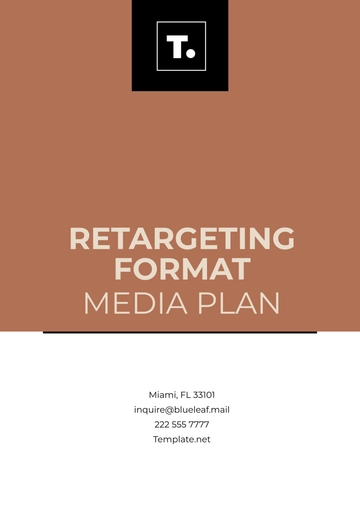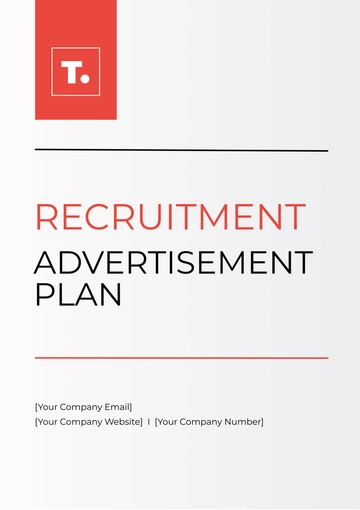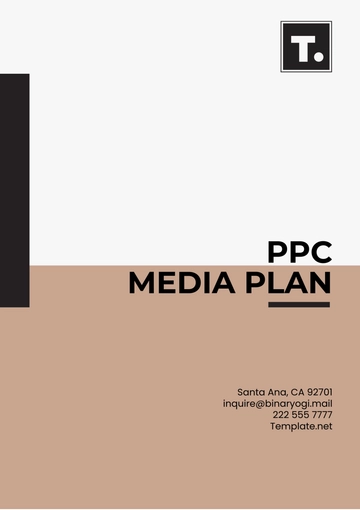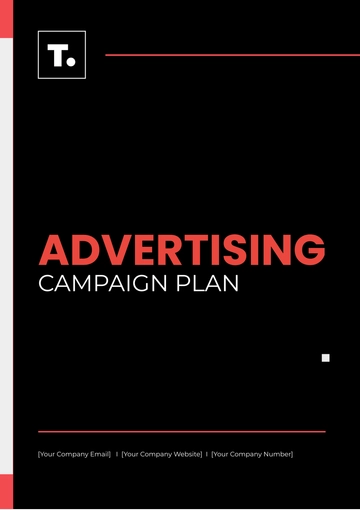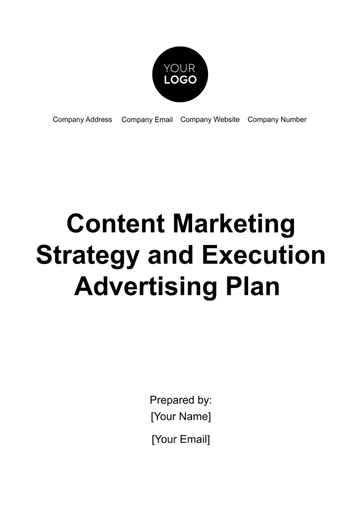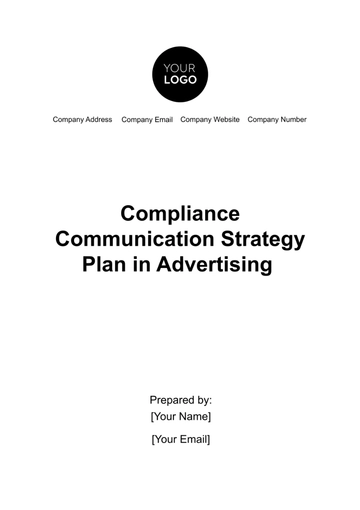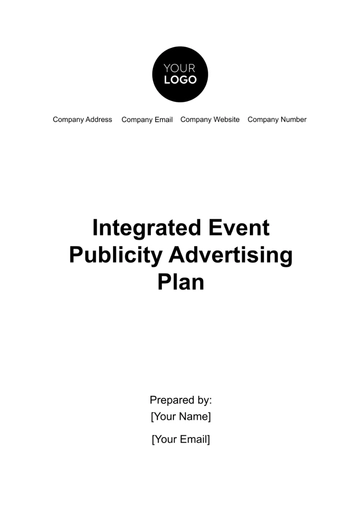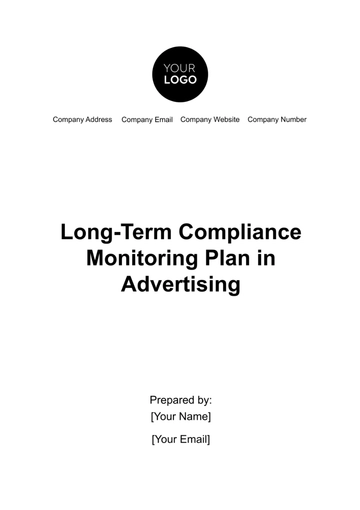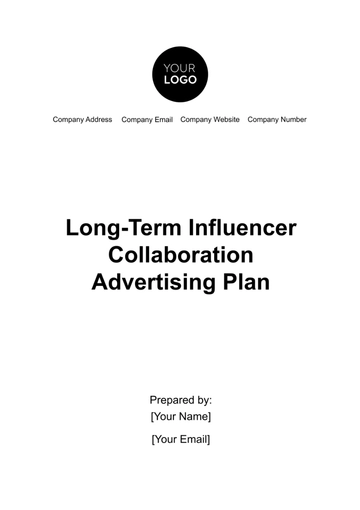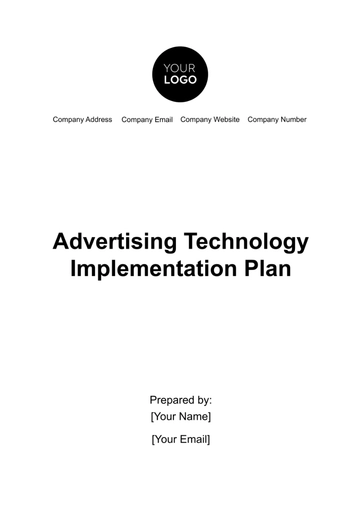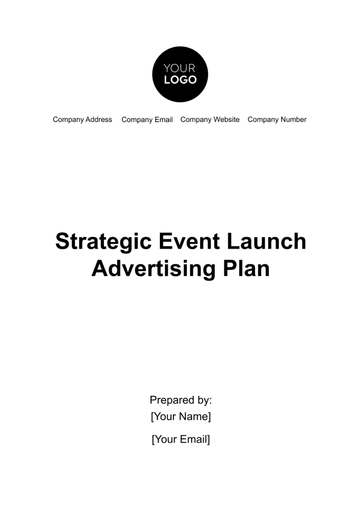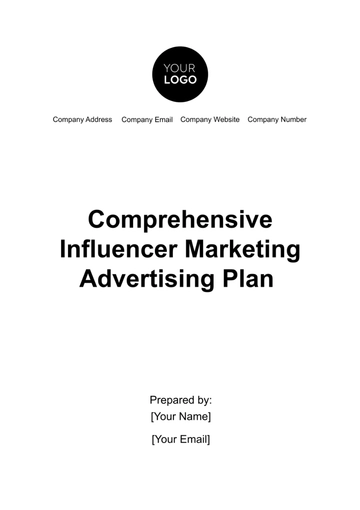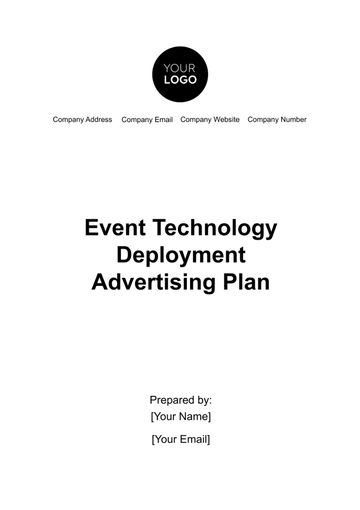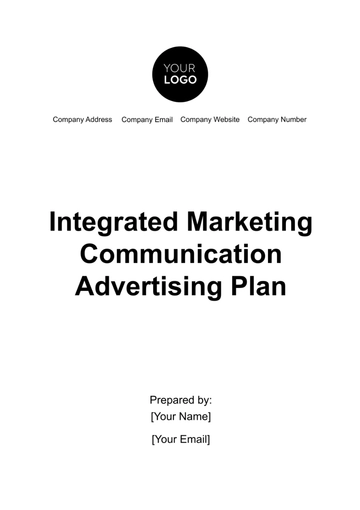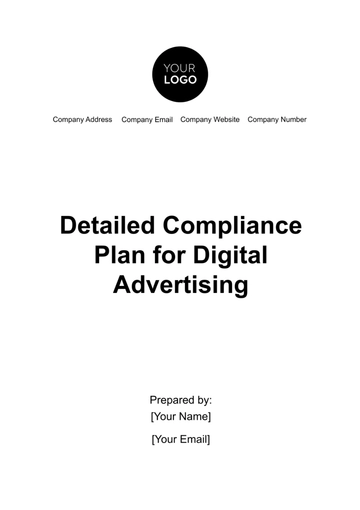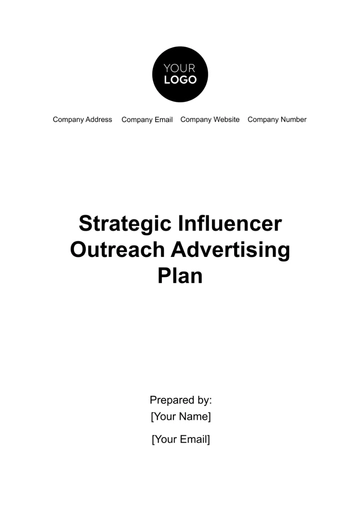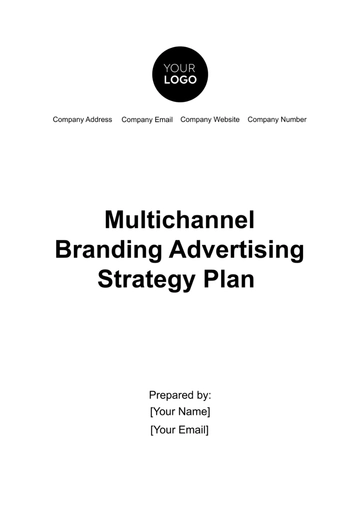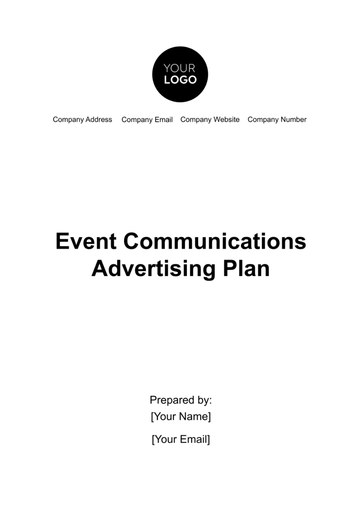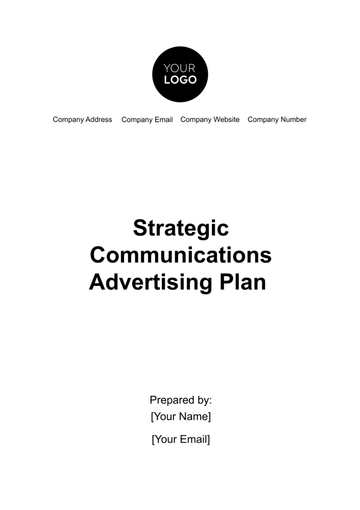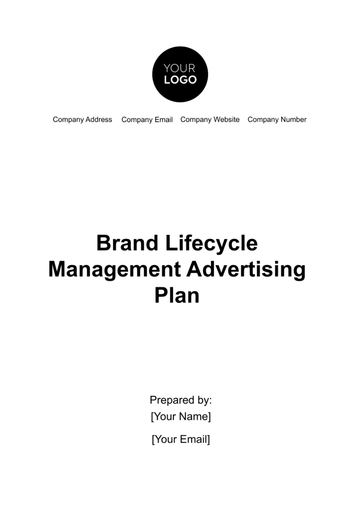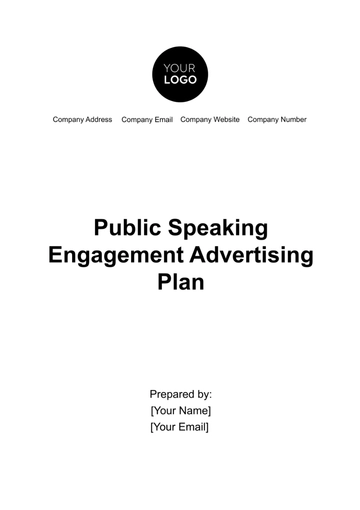Free Integrated Marketing Communication Advertising Plan

1. Executive Summary
This Executive Summary outlines the strategic approach for [Your Company Name]'s Integrated Marketing Communication (IMC) advertising plan. Our aim is to establish a cohesive and impactful marketing campaign that effectively combines various communication tools and channels. This plan is designed to reinforce our brand identity, foster stronger customer relationships, and accelerate business growth.
Objective
Our primary objective is to develop and implement a comprehensive IMC advertising strategy. This strategy is meticulously crafted to enhance brand awareness, significantly increase customer engagement, and consequently drive sales growth. By synchronizing different marketing activities, we aim to create a unified and influential brand message that resonates with our target audience.
Target Market
Our focus is predominantly on small and medium-sized enterprises (SMEs), startups, and digital native brands. These segments have been identified as the most receptive to innovative marketing techniques and represent a significant growth opportunity for [Your Company Name]. By tailoring our approach to these dynamic and evolving sectors, we can address their unique needs and preferences, thereby building strong, long-term relationships.
Key Strategies
To achieve our objectives, we will employ a blend of digital and traditional media, emphasizing the strengths of each channel. Our digital strategy will include targeted online advertising, search engine optimization, and a robust social media presence. Concurrently, traditional media such as print, radio, and television will be used to enhance reach and brand recall. Content marketing will play a pivotal role, engaging audiences with valuable and relevant information. Additionally, social media engagement will be leveraged to create a community around our brand, encouraging interaction and loyalty.
Budget
The budget for this comprehensive plan is estimated at [$000.00]. This budget allocation has been carefully considered to maximize return on investment, ensuring that each element of the plan is adequately funded while maintaining cost-effectiveness.
Timeframe
The proposed timeframe for the implementation of this IMC plan is from [Month Day Year] to [Month Day Year]. This period allows us to develop, execute, and refine our strategies, ensuring that we adapt to market feedback and emerging trends. Regular evaluations will be conducted throughout this period to assess progress and make necessary adjustments.
2. Situational Analysis
The situational analysis provides a comprehensive overview of the current market environment in which [Your Company Name] operates. This section delves into the market trends, competitive landscape, and our internal strengths and weaknesses. By understanding these dynamics, we can better strategize and position our services to capitalize on market opportunities and mitigate potential threats.
Situational Analysis Table
Aspect | Details | Sample Data/Notes |
Market Analysis | Focus on digital platforms and content-driven campaigns. Increasing emphasis on personalization in advertising. | Growing preference for digital media over traditional media. |
Competitor Analysis | Major competitors include [Competitor 1], [Competitor 2], [Competitor 3]. | Our USP: Integrated approach with a balance of creativity and data-driven strategies. |
SWOT Analysis | ||
Strengths | Experienced team, innovative solutions, strong digital presence. | Established client base in digital marketing. |
Weaknesses | Limited brand recognition in the market. | New entrant compared to established competitors. |
Opportunities | Rising demand for digital advertising, potential partnerships. | Emerging markets, growing SME sector. |
Threats | Rapid technological changes, competitive market landscape. | Shifts in digital marketing trends, economic fluctuations. |
This situational analysis sets the foundation for [Your Company Name] to navigate the advertising industry's complex and dynamic landscape. By leveraging our strengths and opportunities while addressing our weaknesses and preparing for potential threats, we can effectively align our marketing strategies with the evolving market demands.
3. Marketing Objectives
The marketing objectives for [Your Company Name] are designed to guide our strategic and tactical actions over the next 12 months. These objectives are specific, measurable, achievable, relevant, and time-bound (SMART), ensuring that they provide a clear direction for our marketing efforts. By setting these goals, we aim to create a focused approach that will drive success in our key business areas: brand awareness, lead generation, customer engagement, and sales growth.
Marketing Objectives Table
Objective Category | Specific Goal | Target / Measurement | Timeframe |
Brand Awareness | Increase brand awareness | Achieve a 30% increase in brand recognition metrics | Within 12 months |
Lead Generation | Generate new leads | Generate 500 new leads per quarter | Quarterly objective |
Customer Engagement | Enhance engagement on social platforms | Increase engagement metrics by 40% on platforms like Facebook, Instagram, LinkedIn | Within 12 months |
Sales Growth | Increase sales revenue | Achieve a 25% increase in sales revenue | Within the first year |
This table outlines the key marketing objectives for [Your Company Name], providing a clear and quantifiable set of goals. By focusing on these core areas, we can align our marketing strategies and tactics to effectively drive business growth and strengthen our market position. Each objective is set with a realistic but ambitious target, ensuring that we push for significant improvements while remaining achievable. The success against these objectives will be regularly monitored and reviewed to ensure ongoing alignment with our overall business strategy.
4. Target Audience
Understanding the target audience is crucial for the success of [Your Company Name]'s marketing efforts. Our target audience is defined not just by basic demographics but also by their psychographic characteristics and behavioral tendencies. This comprehensive approach enables us to tailor our marketing strategies to effectively reach and engage with our audience, ensuring that our messaging resonates and elicits the desired response.
Target Audience Table
Aspect | Category | Details | Notes/Examples |
Demographics | Business Owners | Aged 25-55, decision-makers in various industries. | Focus on SMEs, startups, and established businesses. |
Marketing Managers | Aged 25-55, responsible for marketing in their firms. | Often seeking new and effective marketing solutions. | |
Psychographics | Value-Driven | Seek cost-effective and high-return marketing solutions. | Look for proof of ROI in marketing investments. |
Tech-Savvy | Keen on adopting the latest digital marketing trends. | Responsive to innovative digital marketing campaigns. | |
Behavioral Factors | Seeking Solutions | Actively searching for marketing and advertising solutions. | High engagement with marketing-related content. |
Digital Trends | Highly responsive to new trends in digital marketing. | Quick to adopt new platforms and technologies. |
This table provides a detailed breakdown of our target audience, offering insights into who they are, what drives them, and how they behave. By aligning our marketing strategies with these insights, [Your Company Name] can create more personalized, relevant, and effective marketing campaigns that truly speak to the needs and preferences of our audience. Understanding these aspects of our audience is key to forging stronger connections and driving engagement and conversion.
5. Marketing Strategies
For [Your Company Name], the marketing strategies are the linchpin to achieving our objectives. In today's digital-centric world, our strategies span across various digital platforms, ensuring a comprehensive approach to reach and engage our target audience effectively. From leveraging digital advertising and content marketing to optimizing email marketing and SEO, our strategies are designed to enhance online presence, build brand authority, and drive conversions.
Marketing Strategies Table:
Strategy Type | Description | Key Activities | Platforms/Tools |
Digital Advertising | Utilizing online advertising channels to reach a broader audience. | Creating and managing ad campaigns. | Google Ads, Facebook, Instagram, LinkedIn |
Content Marketing | Developing valuable and engaging content to establish thought leadership. | Blog posts, infographics, whitepapers, and video content. | Company blog, social media, content sharing platforms |
Email Marketing | Sending regular and targeted emails to nurture leads and maintain customer engagement. | Newsletters, promotional emails, lead nurturing campaigns. | Email marketing platforms like Mailchimp or SendGrid. |
SEO Optimization | Enhancing website visibility and ranking on search engines. | Keyword optimization, on-page SEO, link building. | SEO tools like Google Analytics, Moz, SEMrush. |
These strategies represent the core of our marketing approach at [Your Company Name]. Each strategy is tailored to leverage the strengths of different platforms and tools, ensuring that we reach our audience where they are most active and engaged. Digital advertising will help in capturing immediate attention and driving traffic, while content marketing will establish our brand as a knowledgeable and trusted industry leader. Email marketing will nurture our existing leads and customers, keeping them engaged and informed. Lastly, SEO optimization is critical for long-term visibility and organic growth. Together, these strategies form a robust marketing plan designed to achieve our objectives and grow [Your Company Name]'s presence in the market.
6. Tactical Plan
The tactical plan for [Your Company Name] translates our marketing strategies into actionable steps. This plan is focused on effectively executing campaigns across various channels, ensuring consistent and engaging communication with our target audience. By meticulously planning our social media campaigns, Google Ads, content creation, and email marketing efforts, we aim to create a cohesive and dynamic marketing mix that drives results.
Tactic | Description | Execution Details | Frequency/Timing |
Social Media Campaigns | Engaging the audience with themed content. | Monthly themes, weekly posts, featuring customer stories, interactive posts. | Monthly theme, weekly posts. |
Google Ads Campaigns | Running targeted ad campaigns. | Focused on high-conversion keywords, A/B testing for optimization. | Ongoing, with regular reviews and adjustments. |
Content Calendar | Consistent creation of engaging and informative content. | Bi-weekly blog posts on industry topics, quarterly whitepapers for in-depth analysis. | Bi-weekly for blogs, quarterly for whitepapers. |
Email Blasts | Keeping the audience informed and engaged through emails. | Monthly newsletters for updates and information, bi-weekly promotional emails for offers and services. | Monthly for newsletters, bi-weekly for promotional emails. |
This tactical plan is designed to operationalize our marketing strategies, ensuring that each element works in harmony to achieve our marketing objectives. Social media campaigns will keep our audience engaged and informed, while Google Ads will drive targeted traffic and leads. The content calendar ensures a steady stream of valuable content, establishing [Your Company Name] as an authority in our field. Finally, regular email blasts will keep our audience engaged, fostering long-term relationships. Through this tactical approach, we aim to build a strong and loyal customer base, driving both brand awareness and sales growth for [Your Company Name].
7.Budget Allocation
The budget allocation for [Your Company Name]'s marketing activities is a critical component of our overall marketing plan. It outlines the financial investment dedicated to each key marketing activity, ensuring that resources are efficiently allocated to maximize impact and return on investment. This section provides a clear and structured overview of the financial commitments towards digital advertising, content marketing, email marketing, and SEO optimization. By judiciously allocating the budget, we aim to balance cost-effectiveness with high-performance marketing initiatives, enabling [Your Company Name] to achieve its marketing objectives within the set financial parameters.
Marketing Activity | Allocation | Details |
Digital Advertising | [$1000] | Google Ads, Social Media Ads |
Content Marketing | Blogging, Infographics | |
Email Marketing | Newsletters, Targeted Campaigns | |
SEO Optimization | Website Enhancement |
8. Measurement and Evaluation
The measurement and evaluation phase is integral to [Your Company Name]'s marketing strategy. This phase focuses on assessing the effectiveness of our marketing efforts through a set of Key Performance Indicators (KPIs). By regularly monitoring and analyzing these KPIs, we can gain valuable insights into the performance of our campaigns, enabling us to make informed decisions and strategic adjustments. The use of sophisticated tools like Google Analytics, CRM systems, and Social Media Analytics ensures accurate tracking and interpretation of data.
Measurement and Evaluation Table
KPI | Description | Target/Goal | Tools for Measurement |
Website Traffic | The volume of visitors to our website. | Increase traffic by X% over Y months. | Google Analytics |
Lead Generation | Number of new leads acquired. | Generate Z new leads per quarter. | CRM Systems |
Conversion Rates | Percentage of visitors who take the desired action. | Improve conversion rates by X% within Y months. | Google Analytics, CRM Systems |
Social Media Engagement | Level of audience interaction on social platforms. | Enhance engagement metrics by X% within Y months. | Social Media Analytics tools like Hootsuite, Buffer |
Sales Revenue | Total sales generated from marketing efforts. | Increase sales revenue by X% over Y months. | CRM Systems, Sales Data Analysis |
This table represents a comprehensive approach to measuring and evaluating the effectiveness of our marketing strategies. By setting clear targets for each KPI and utilizing the appropriate tools for measurement, [Your Company Name] can ensure that our marketing initiatives are not only effective but also aligned with our overall business objectives. Regular analysis of these KPIs will allow for timely adjustments in our marketing tactics, ensuring continuous improvement and growth in our marketing efforts.
9. Contingency Plan
it is crucial for [Your Company Name] to have a robust contingency plan in place. This plan outlines the potential risks that could impact our marketing efforts and the corresponding strategies to mitigate these risks. By anticipating and preparing for changes in digital advertising regulations and economic downturns, we can ensure that our marketing strategy remains resilient and adaptable. This proactive approach allows us to maintain momentum even in the face of unforeseen challenges.
Contingency Plan Table
Risk Category | Potential Risks | Mitigation Strategies | Implementation Notes |
Regulatory Changes | Changes in digital advertising regulations. | Stay informed about regulatory changes, adapt marketing strategies accordingly. | Regular monitoring of legal and regulatory updates, training sessions for the marketing team. |
Economic Factors | Economic downturns affecting marketing budgets and consumer spending. | Agile budget adjustments, focus on cost-effective marketing channels. | Financial planning to allocate resources flexibly, emphasize high ROI activities. |
Market Dynamics | Shifts in market trends and consumer preferences. | Diversify marketing channels to reach a broader audience. | Continuous market analysis, adopting emerging platforms and trends. |
This table presents a clear outline of the potential risks and the strategies to mitigate them. By diversifying our marketing channels and remaining agile in our budgeting, [Your Company Name] can navigate through regulatory changes and economic fluctuations effectively. Continuous market analysis will enable us to stay ahead of trends, ensuring that our marketing efforts remain relevant and impactful. This contingency plan is a vital part of our strategy, ensuring that we are prepared to face challenges and adapt to changing circumstances, thereby safeguarding the success of our marketing initiatives.
10. Conclusion
This IMC Advertising Plan provides a roadmap for [Your Company Name] to effectively reach and engage its target audience, leveraging a mix of traditional and digital marketing strategies. The focus on measurable outcomes and flexibility in execution ensures adaptability in a dynamic market environment.
Contact Information:
Company Name: [Your Company Name]
Address: [Your Company Address]
Email: [Your Company Email]
Phone: [Your Company Phone Number]
Website: [Your Company Website]
Social Media: [Your Social Media]
- 100% Customizable, free editor
- Access 1 Million+ Templates, photo’s & graphics
- Download or share as a template
- Click and replace photos, graphics, text, backgrounds
- Resize, crop, AI write & more
- Access advanced editor
Introducing Template.net's Integrated Marketing Communication Advertising Plan Template. Editable and customizable with our Ai Editor Tool, this template simplifies the process of creating comprehensive marketing communication strategies. Strategize across various channels seamlessly and effectively with Template.net's innovative solutions.
You may also like
- Finance Plan
- Construction Plan
- Sales Plan
- Development Plan
- Career Plan
- Budget Plan
- HR Plan
- Education Plan
- Transition Plan
- Work Plan
- Training Plan
- Communication Plan
- Operation Plan
- Health And Safety Plan
- Strategy Plan
- Professional Development Plan
- Advertising Plan
- Risk Management Plan
- Restaurant Plan
- School Plan
- Nursing Home Patient Care Plan
- Nursing Care Plan
- Plan Event
- Startup Plan
- Social Media Plan
- Staffing Plan
- Annual Plan
- Content Plan
- Payment Plan
- Implementation Plan
- Hotel Plan
- Workout Plan
- Accounting Plan
- Campaign Plan
- Essay Plan
- 30 60 90 Day Plan
- Research Plan
- Recruitment Plan
- 90 Day Plan
- Quarterly Plan
- Emergency Plan
- 5 Year Plan
- Gym Plan
- Personal Plan
- IT and Software Plan
- Treatment Plan
- Real Estate Plan
- Law Firm Plan
- Healthcare Plan
- Improvement Plan
- Media Plan
- 5 Year Business Plan
- Learning Plan
- Marketing Campaign Plan
- Travel Agency Plan
- Cleaning Services Plan
- Interior Design Plan
- Performance Plan
- PR Plan
- Birth Plan
- Life Plan
- SEO Plan
- Disaster Recovery Plan
- Continuity Plan
- Launch Plan
- Legal Plan
- Behavior Plan
- Performance Improvement Plan
- Salon Plan
- Security Plan
- Security Management Plan
- Employee Development Plan
- Quality Plan
- Service Improvement Plan
- Growth Plan
- Incident Response Plan
- Basketball Plan
- Emergency Action Plan
- Product Launch Plan
- Spa Plan
- Employee Training Plan
- Data Analysis Plan
- Employee Action Plan
- Territory Plan
- Audit Plan
- Classroom Plan
- Activity Plan
- Parenting Plan
- Care Plan
- Project Execution Plan
- Exercise Plan
- Internship Plan
- Software Development Plan
- Continuous Improvement Plan
- Leave Plan
- 90 Day Sales Plan
- Advertising Agency Plan
- Employee Transition Plan
- Smart Action Plan
- Workplace Safety Plan
- Behavior Change Plan
- Contingency Plan
- Continuity of Operations Plan
- Health Plan
- Quality Control Plan
- Self Plan
- Sports Development Plan
- Change Management Plan
- Ecommerce Plan
- Personal Financial Plan
- Process Improvement Plan
- 30-60-90 Day Sales Plan
- Crisis Management Plan
- Engagement Plan
- Execution Plan
- Pandemic Plan
- Quality Assurance Plan
- Service Continuity Plan
- Agile Project Plan
- Fundraising Plan
- Job Transition Plan
- Asset Maintenance Plan
- Maintenance Plan
- Software Test Plan
- Staff Training and Development Plan
- 3 Year Plan
- Brand Activation Plan
- Release Plan
- Resource Plan
- Risk Mitigation Plan
- Teacher Plan
- 30 60 90 Day Plan for New Manager
- Food Safety Plan
- Food Truck Plan
- Hiring Plan
- Quality Management Plan
- Wellness Plan
- Behavior Intervention Plan
- Bonus Plan
- Investment Plan
- Maternity Leave Plan
- Pandemic Response Plan
- Succession Planning
- Coaching Plan
- Configuration Management Plan
- Remote Work Plan
- Self Care Plan
- Teaching Plan
- 100-Day Plan
- HACCP Plan
- Student Plan
- Sustainability Plan
- 30 60 90 Day Plan for Interview
- Access Plan
- Site Specific Safety Plan

